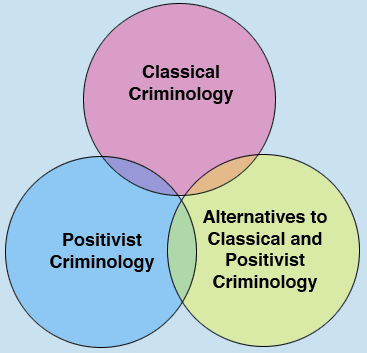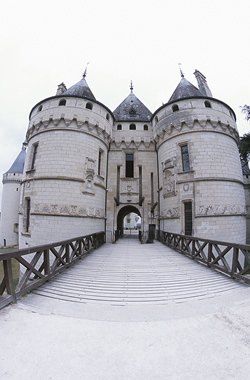Lesson 1: An Introduction to Theory and Crime (Printer Friendly Format)
page 1 of 10
An Introduction to Theory and Crime
Lesson Overview
The purpose of this lesson is to learn about the importance of understanding crime causation. This first lesson provides the basic foundation for this course and thus it is important that the student understand the major concepts introduced here. These concepts and underlying ideas will be found throughout the rest of the course lessons. Understanding explanations for why people commit crime is important for two reasons.
First, if we can understand why people commit crime, we can develop ways to address the crime problem. Second, it has been found that ideas about punishments, e.g. what should be done to people who commit crime, are directly related to individuals' thinking about what causes people to commit them. The approach that society takes takes to address the crime problem, through the instruments associated with the criminal justice system (police, courts, prosecution, corrections, etc.), is rooted in criminological theory. For example, if most of the members of society believe that crime is caused because of something internal to the individual, e.g. free will, then society is more likely to enact a series of laws that are designed to apply greater punishment to law breaking behavior. On the other hand, if people believe that crime is caused by forces external to the individual, e.g. the environment, society is more likely to apply lesser punishment for law-breaking behavior and develop efforts toward turning so-called criminals into law-abiding citizens (sometimes referred to rehabilitation).
This course is aimed at introducing the student to many criminological theories that have been developed through the years to explain law-breaking behavior as well as those theories that question the law-making process and that question society's reaction to law breaking behavior.
Lesson Objectives
By the end of this lesson, you should be able to:
- Define the term"theory" as it relates to criminological theory.
- Name the five criteria associated with the evaluation of criminological theories.
- Provide a general description of the historical development of major criminological theories.
- Think about the causations of crime from different perspectives.
- Realize that the causation that people attribute to crime quite often determines their attitudes toward punishment.
page 2 of 10
Thought-Provoking Exercise
 Stop for a moment and think about a crime occurring right now. It can be any type of crime and the characteristics associated with that crime are totally up to you. Quickly now ... without spending a lot of time thinking about this, jot down your "off the top of the head" response to the following questions: Stop for a moment and think about a crime occurring right now. It can be any type of crime and the characteristics associated with that crime are totally up to you. Quickly now ... without spending a lot of time thinking about this, jot down your "off the top of the head" response to the following questions:
- What type of crime was occurring as you went through this exercise?
- What was the race, age, and gender of the offender?
- What was the race, age, and gender of the victim?
- What type of crime was occurring?(e.g. property crime, violent crime, etc.)
Now, thinking about the offender only, what do you think might have led that person to commit that crime? You can provide more than one possibility.
Finally, jot down what you think should be done to that offender when it comes to an appropriate punishment.
Post your thoughts to the Lesson 1 Crime and Punishment discussion forum in Week 01 folder. |
page 3 of 10
 Reading Assignments
Reading Assignments
-
The textbook reading assigned for this lesson is Chapter 1 in Vold, Bernard and Snipes' Theoretical Criminology (2002). You are expected to have completed the reading before you proceed to the instructor's commentaries for this lesson.
- Review the PowerPoint Presentation on Chapter 1.
- Take the RAT 01 (Reading Assessment Test for Chapter 1).
page 4 of 10
What Is Theory?
 Theory is defined as a statement about the relationship between two or more social phenomena, the purpose of which is to predict and/or explain those phenomena. Criminological theories are used to explain the facts about crime. There are many facts about crime that need explaining.
Theory is defined as a statement about the relationship between two or more social phenomena, the purpose of which is to predict and/or explain those phenomena. Criminological theories are used to explain the facts about crime. There are many facts about crime that need explaining.
In the beginning of this lesson, you were asked to think quickly about a crime that was occurring (hypothetically, of course). Then you were asked to respond to questions about that crime, the offender, and the victim. In the drawbridge exercise, you were given a scenario and then asked to think about to which of the characters the most blame for the death of the Baroness should be attributed. The purpose of both of these exercises is to get you to begin to think about crime causation as a complex puzzle.
"Facts about crimes" here refers to the complex existence of many possible causes of the criminal act. It is highly unlikely that crime is caused by any one thing. Through empirical (another term for scientific) studies, researchers have discovered just the opposite: crime is caused by multiple factors. For example, we know, because of these studies and because of what crime statistics tell us, that more males than females engage in crime. Thus, one "fact" about crime causation is that "males are more likely than are females to become involved in criminal activities." Theory can help us explain why this might be so. We will discuss these theories as we move through this course.
There is one important thing to keep in mind as you begin to explore the criminological theories that will be introduced to you throughout this course. In order for some idea to be considered a theory, researchers must be able to attempt to disprove it. In other words, if the theory cannot be tested scientifically, it is not a theory. It might be an idea or a hunch about something, but it is not a theory. The example I use most often is the statement, "There is a God." This is an idea that is faith-based; it cannot be tested so no effort to disprove it can occur. Thus, it is not a theory. Criminology is the scientific study of crime causation, and although ideas about things that cannot be tested are not at all to be discouraged, this course is about what is, and not about what ought to be. The more your read in the textbook, the clearer this particular definition will become as you get deeper into the course content and discussions.
page 5 of 10
Theoretical Building Blocks
Theories consist of basic components. You should be able to understand these theoretical building blocks and apply them to the theories to which you will be introduced in subsequent lessons.
- Major premise: the statement the theory is making about crime causation (or delinquency, or deviant behavior).
- Propositions: a series of statements about the relationship between two or more variables or social phenomena.
- Concepts: those terms within the major propositions that will be operationalized in such a way that will allow them to be observed (measured).
As stated above, think carefully about these theoretical building blocks as you read about a new theory. Can you talk about the theory in terms of its major premise, propositions, and concepts? If you can, you have a comprehensive understanding of the theory.
page 6 of 10
Five Criteria of Evaluating Theories
 Throughout this course you will learn about a variety of criminological theories, all developed to explain deviant behavior (behavior that goes against society's norms and values), delinquency (behavior that if committed by an adult would be considered a crime) and crime (behavior committed by an adult that is in direct violation of a law). These theories have received a great deal of attention, and not always by academic scholars and researchers alone. Public officials have also paid attention to these theories and often developed intervention programs directed at reducing crime in society based on the major propositions and concepts associated with the theories. In order to determine whether a theory is "good" or useful to society, that is to say, to what extent it can predict or explain crime, Akers (1994) developed five criteria for just that purpose.
Throughout this course you will learn about a variety of criminological theories, all developed to explain deviant behavior (behavior that goes against society's norms and values), delinquency (behavior that if committed by an adult would be considered a crime) and crime (behavior committed by an adult that is in direct violation of a law). These theories have received a great deal of attention, and not always by academic scholars and researchers alone. Public officials have also paid attention to these theories and often developed intervention programs directed at reducing crime in society based on the major propositions and concepts associated with the theories. In order to determine whether a theory is "good" or useful to society, that is to say, to what extent it can predict or explain crime, Akers (1994) developed five criteria for just that purpose.
- Is the theory logical? Does the theory make sense?
Example: Is it logical to say that poverty is related to crime?
- Can the theory be tested? Remember, if we cannot develop a way to observe something, we cannot test it.
Example: Can we observe (another way of saying "measure" the existence of a God? On the other hand, we can observe poverty?
- Has the theory received some empirical support? When researchers conduct studies to test the theory, have they found support for it?
Example: Have they found a relationship between poverty and crime?
- Is the theory broad in scope, yet parsimonious? The theory needs to be able to explain more than a small subsection of crime and it needs to do so with as few major concepts as possible.
Example: A theory that explains all theft does us more good than one that can explain shoplifting only (broad in scope). And the fewer number of major concepts a theory has, the less trouble it is to try to find a way to measure those concepts (parsimony).
- Does the theory have some "real world" use? Can we use the theory to do something about crime in society?
Example: If biological theory finds support in that some "criminal gene" is discovered, what would we do with that information? (This is only one of many ethical questions we will explore later on in this course.)
Understanding these five criteria and applying them to the theories to which you will be introduced in subsequent lessons is critical. Just as you are being asked to be able to think about theory using the theoretical building blocks above, you will be asked (at least periodically) to evaluate individual theories using these five criteria. If you can do that, you will be adding greatly to your knowledge base of theory.
page 7 of 10
Causation As It Relates to the Study of Crime
Researchers often talk about theory in terms of:
X  Y
Y
Where, X = cause
Y = effect
 In other words, X happened first, and then there was a change in Y. In research terms, we call X the independent variable and Y the dependent variable. For now, just know that we are saying that Y is caused by X.
In other words, X happened first, and then there was a change in Y. In research terms, we call X the independent variable and Y the dependent variable. For now, just know that we are saying that Y is caused by X.
But we cannot say in exact terms that Y was caused by X unless we can establish:
- X preceded Y, e.g. X actually did occur before Y (temporal ordering);
- There is a statistical relationship between X and Y (through statistical analysis we have determined that X and Y are correlated (related);
- In the presence of other Xs, the relationship between X and Y does not disappear (e.g. what else might have caused Y and when those other causes are introduced into the statistical model, will the relationship between X and Y still exist?)
This is sometimes referred to as the criteria for causation and it is no easy task. In fact, you would be hard pressed to find a researcher who would state emphatically that X CAUSED Y. Rather, we often talk in terms of probabilities. For example, we say that in the presence of X, it is more probable than not that a change in Y will occur. In other words, just because we have established a relationship between X and Y does not mean that X caused Y, or, correlation does not mean causation.
page 8 of 10
A Historical Perspective of Theories in Crime and Delinquency
The historical timeline below attempts to capture the evolution of ideas about crime and punishment as pointed out by your text for this course. Become familiar with this early history and you will see that as time advanced, humans began to move away from the inquisitorial system of justice where people were guilty until they proved themselves innocent and toward the adversarial system of justice where people were innocent until they were proven guilty. The religious leaders in the Middle Ages and up through the 18th century had a strong hold on individual belief systems. If people behaved inappropriately, it was thought such behavior was caused by an evil spirit. Conversely, if people were innocent, it was believed that God would protect and save them.
Early philosophers in the 16th and early 17th centuries such as Hobbes and Descartes challenged the thinking of the religious leaders of the day. They believed that only that which could be observed could be known. In other words, only through direct observation of humans in their natural environments could we understand human behavior. Hobbes believed that humans, left to their own devices, would not always behave appropriately, and called for the need of a civil government in the form of a social contract. Descartes, sometimes referred to as the father of philosophy, was adamant about understanding any phenomenon only through careful observations. This would go against using spiritual or not of this world explanations.
We will talk more about the ushering in of the adversarial system of justice sometime in the early 1700s and by way of Cesare Beccaria (Italian philosopher) in his writing of On Crime and Punishment in 1764 in our later discussions of classical criminology. For now, just know that this was the beginning of the modern-day criminal justice system and a time that called for the end of torture, trials by ordeal, etc. A new system of justice was advocated by Beccaria and his followers; a system where people were innocent until the government proved them guilty.

Figure 1.1: The Evoluation of Ideas about Crime and Punishment
page 9 of 10
Major Theoretical Schools of Thought
 Since sociologists and criminological theorists (sometimes the same person!) began to write about crime causation (1700s forward) they have attempted to separate out theories into meaningful categories (or paradigms, schools of thought, etc.). Although open to debate (and sociologists love to debate!), there are three major such schools of thought. The first is Classical Criminology and finds its roots in Cesare Beccaria's On Crimes and Punishment (1764). This school attributes crime to individual free will, and argues that people engage in weighing the costs and the benefits associated with the criminal event (hedonistic calculus) before determining whether such behavior is worth the likely gain (or pleasure vs. pain principle). From this perspective, the only way to avoid crime is to make it painful. In other words, only a strict crime control model will deter crime.
Since sociologists and criminological theorists (sometimes the same person!) began to write about crime causation (1700s forward) they have attempted to separate out theories into meaningful categories (or paradigms, schools of thought, etc.). Although open to debate (and sociologists love to debate!), there are three major such schools of thought. The first is Classical Criminology and finds its roots in Cesare Beccaria's On Crimes and Punishment (1764). This school attributes crime to individual free will, and argues that people engage in weighing the costs and the benefits associated with the criminal event (hedonistic calculus) before determining whether such behavior is worth the likely gain (or pleasure vs. pain principle). From this perspective, the only way to avoid crime is to make it painful. In other words, only a strict crime control model will deter crime.
The second school of thought, Positivist Criminology, disagrees with the Classical perspective and argues that crime is caused by many things. Behavior is determined by multiple causes and the only way to do something about crime is to understand and do something about its root causes. This perspective calls for rehabilitation, or efforts to discover why people behave the way they do and get them the appropriate treatment they need in order to live crime free.
The third school of thought goes by many names and can sometimes seem confusing to the lay person. We will refer to this third perspective as Alternatives to Classical and Positivist Criminology. This perspective is often called radical as it questions the legal order and the way in which society reacts to law-breaking behavior. Questions asked by radical criminologists might include: Who gets to say what is deviant or unlawful behavior? Is the criminal justice system just an arm of the ruling class? Is the criminal justice system fair and equitable in its dealings with all people? Could it be possible that what we do to people once they do break the law makes them worse off than if we had just left them alone?
Of course, we will find some overlap across these major paradigms, but understanding why a theory falls under one of these schools of thought will prove useful to the student of criminological theory.
page 10 of 10
Summary
With the materials presented here, along with the PowerPoint presentation and a close reading of Chapter 1 in Vold, Bernard and Snipes' Theoretical Criminology, I hope that you can see the importance of first understanding what theory is all about before diving off into learning about individual theories. Think of the information provided in this lesson as the foundation for all that is to come after it. To reiterate, understand that exploring theory is an undertaking that is separate from ideas about things that cannot be measured or observed. Criminology is the scientific study of crime causation, and through the years, theorists have carefully developed theories and their major building blocks. Theories do not escape close scrutiny, and have been evaluated through empirical testing and their "real world" application. Researchers are cautious, however, even when they find support for one theory or the other to say that "X caused Y." This is because they realize that not every possible cause of crime can be included in even the most sophisticated theoretical and statistical model.
Theorists have moved beyond the early days of the inquisition just as governments have (at least MOST governments have; sadly, others have not). Yet, sometimes lay people, and perhaps some theorists, are more apt to attribute crime to some force that cannot be seen and thus cannot be measured. But in this course, you are "deputized theorists and social scientists" and, as such, are asked to examine human behavior and its causes only through the lenses of science! In the end, try to determine to which school of criminological thought you most closely align (classical, positivism, or radical theory), but hold off on making any decision until your journey through subsequent lessons is complete!
 Wrap-Up Activity: The Drawbridge Exercise
Wrap-Up Activity: The Drawbridge Exercise
Please read the story, then follow the directions below.
THE DRAWBRIDGE EXERCISE

As he left for a visit to his outlying districts, the jealous Baron warned his pretty wife: "Do not leave the castle while I am gone, or I will punish you severely when I return!"
But as the hours passed, the young Baroness grew lonely, and despite her husband's warning, decided to visit her Lover who lived in the countryside nearby.
The castle was located on an island on a wide, fast flowing river, with a drawbridge linking the island and the land at the narrowest point on the river.
"Surely my husband will not return before dawn," she thought, and ordered her servants to lower the drawbridge and leave it down until she returned.
After spending several pleasant hours with the Lover, the Baroness returned to the drawbridge, only to find it blocked by a Madman wildly waving a long and extremely sharp knife.
"Do not attempt to cross this bridge, Baroness, or I will kill you," he raved. Fearing for her life, the Baroness returned to her lover and asked him for help.
"Our relationship is only a romantic one," he said, "I will not help." The Baroness then sought out a Boatman on the river, explained her plight to him, and asked him to take her across the river in his boat.
"I will do it, but only if you can pay my fee of five Marks."
"But I have no money with me!" the Baroness protested.
"That is too bad. No money, no ride," the Boatman said flatly.
Her fear growing, the Baroness ran crying to the home of a Friend, and after again explaining the situation, begged for enough money to pay the Boatman his fee.
"If you had not disobeyed your husband, this would not have happened," the Friend said. "I will give you no money."
With dawn approaching and her last resource exhausted, the Baroness returned to the bridge in desperation, attempted to cross to the castle, and was slain by the Madman. |
DIRECTIONS
In the story above, there are six characters. They are (in alphabetical order):
The Baron
The Baroness
The Boatman
The Friend
The Lover
The Madman
- Using the list above, rank the characters (from 1 to 6) in order of their responsibility for the death of Baroness.
- Go to your group discussion space. Share your list on the Lesson 1 Drawbridg Exercise discussion forum, and work with the other members of your group and decide on a group rank order for the six characters.
- Have one of your group members to post your group decision with the supporting arguments to the Lesson 1 Drawbridge Character Rank discussion forum in the Week 01 folder. Make sure to identify your group number.
 Stop for a moment and think about a crime occurring right now. It can be any type of crime and the characteristics associated with that crime are totally up to you. Quickly now ... without spending a lot of time thinking about this, jot down your "off the top of the head" response to the following questions:
Stop for a moment and think about a crime occurring right now. It can be any type of crime and the characteristics associated with that crime are totally up to you. Quickly now ... without spending a lot of time thinking about this, jot down your "off the top of the head" response to the following questions:  Theory is defined as a statement about the relationship between two or more social phenomena, the purpose of which is to predict and/or explain those phenomena. Criminological theories are used to explain the facts about crime. There are many facts about crime that need explaining.
Theory is defined as a statement about the relationship between two or more social phenomena, the purpose of which is to predict and/or explain those phenomena. Criminological theories are used to explain the facts about crime. There are many facts about crime that need explaining. Throughout this course you will learn about a variety of criminological theories, all developed to explain deviant behavior (behavior that goes against society's norms and values), delinquency (behavior that if committed by an adult would be considered a crime) and crime (behavior committed by an adult that is in direct violation of a law). These theories have received a great deal of attention, and not always by academic scholars and researchers alone. Public officials have also paid attention to these theories and often developed intervention programs directed at reducing crime in society based on the major propositions and concepts associated with the theories. In order to determine whether a theory is "good" or useful to society, that is to say, to what extent it can predict or explain crime, Akers (1994) developed five criteria for just that purpose.
Throughout this course you will learn about a variety of criminological theories, all developed to explain deviant behavior (behavior that goes against society's norms and values), delinquency (behavior that if committed by an adult would be considered a crime) and crime (behavior committed by an adult that is in direct violation of a law). These theories have received a great deal of attention, and not always by academic scholars and researchers alone. Public officials have also paid attention to these theories and often developed intervention programs directed at reducing crime in society based on the major propositions and concepts associated with the theories. In order to determine whether a theory is "good" or useful to society, that is to say, to what extent it can predict or explain crime, Akers (1994) developed five criteria for just that purpose. In other words, X happened first, and then there was a change in Y. In research terms, we call X the independent variable and Y the dependent variable. For now, just know that we are saying that Y is caused by X.
In other words, X happened first, and then there was a change in Y. In research terms, we call X the independent variable and Y the dependent variable. For now, just know that we are saying that Y is caused by X.
 Since sociologists and criminological theorists (sometimes the same person!) began to write about crime causation (1700s forward) they have attempted to separate out theories into meaningful categories (or paradigms, schools of thought, etc.). Although open to debate (and sociologists love to debate!), there are three major such schools of thought. The first is Classical Criminology and finds its roots in Cesare Beccaria's On Crimes and Punishment (1764). This school attributes crime to individual free will, and argues that people engage in weighing the costs and the benefits associated with the criminal event (hedonistic calculus) before determining whether such behavior is worth the likely gain (or pleasure vs. pain principle). From this perspective, the only way to avoid crime is to make it painful. In other words, only a strict crime control model will deter crime.
Since sociologists and criminological theorists (sometimes the same person!) began to write about crime causation (1700s forward) they have attempted to separate out theories into meaningful categories (or paradigms, schools of thought, etc.). Although open to debate (and sociologists love to debate!), there are three major such schools of thought. The first is Classical Criminology and finds its roots in Cesare Beccaria's On Crimes and Punishment (1764). This school attributes crime to individual free will, and argues that people engage in weighing the costs and the benefits associated with the criminal event (hedonistic calculus) before determining whether such behavior is worth the likely gain (or pleasure vs. pain principle). From this perspective, the only way to avoid crime is to make it painful. In other words, only a strict crime control model will deter crime. Wrap-Up Activity: The Drawbridge Exercise
Wrap-Up Activity: The Drawbridge Exercise